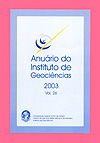Holocene sea-level history along eastern-southeastern Brazil
DOI:
https://doi.org/10.11137/2003_0_13-24Abstract
Relative sea-level curves have been delineated for several sectors of the Brazilian coast. In order to have homogeneous and consistent curves, very short segments of the coastline with the same framework are considered. To minimize systematic errors tied to the particular nature of an indicator, we use the maximum number of different indicators available from former positions of relative sea level. These sea-level curves show that, during the last 7000 years, the central Brazilian coast has been subjected to a submergence phase which lasted until 5100 14C yr BP (5600 cal yr BP), followed by a drop in sea level. This drop in sea level was not continuous but was interrupted by two high-frequency oscillations. The Salvador curve, the most detailed, can be used as a reference for the central portion of the Brazilian coastline. It is now presented with corrections for isotopic fractionation and reservoir effects as well as calibrations for astronomical ages. Additional supporting evidence for the existence of high-frequency oscillations is provided. They are of the same magnitude as is predicted for the future under greenhouse conditions. These data will help us to understand how the coastal systems will respond to these sea-level changes.Downloads
Download data is not yet available.
Downloads
Published
2003-01-01
How to Cite
Martin, L. (2003) “Holocene sea-level history along eastern-southeastern Brazil”, Anuário do Instituto de Geociências. Rio de Janeiro, BR, 26, pp. 13–24. doi: 10.11137/2003_0_13-24.
Issue
Section
Article
License
This journal is licensed under a Creative Commons — Attribution 4.0 International — CC BY 4.0, which permits use, distribution and reproduction in any medium, provided the original work is properly cited.















